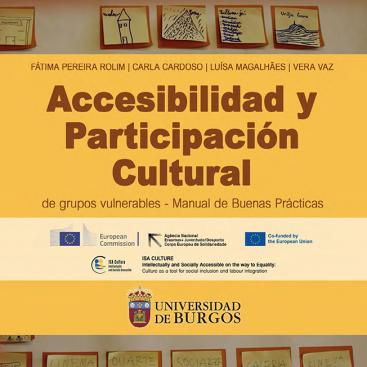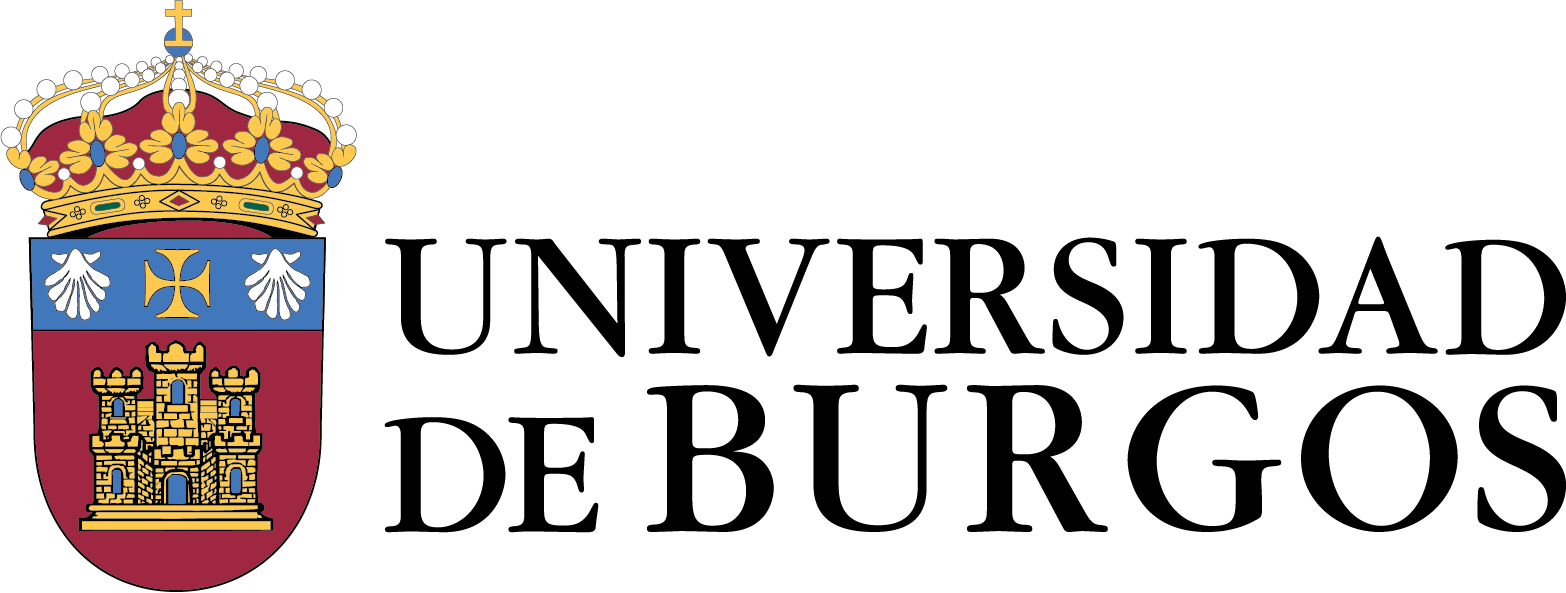Accesibilidad y participación cultural de grupos vulnerables. Manual de buenas prácticas
Keywords:
manual, good practices, vulnerable people, culture, accessibility, inclusion, practical experiencieSynopsis
The Good Practices Manual presents the outcomes of the international Erasmus+ project ISA CULTURE: INTELLECTUALLY AND SOCIALLY ACCESSIBLE – On the way to equality: culture as a tool for social inclusion and labour integration (Erasmus+ 2022-2-PT02-KA220-YOU-000094042), which focused on Cultural Accessibility and Participation for vulnerable groups. The main objective was to design, implement, and evaluate innovative strategies to democratise access to culture, particularly among vulnerable populations, through a participatory and cross-sectoral methodology.
The project was developed within the framework of a transnational institutional alliance comprising cultural, academic, and social organisations, supported by European bodies. Its aim was to foster inclusive cultural practices through research, training, and the implementation of pilot actions. Success indicators were defined in relation to social impact, inclusive participation, and the transfer of good practices.
The methodological approach unfolded across seven key stages, beginning with the identification of the central problem—namely, the lack of equitable access to culture—and the definition of specific objectives. A collaborative consortium was established, target audiences were identified, and the "5W2H" method was applied to conduct a structured initial diagnosis. Data collection combined secondary sources (literature review, cultural policy analysis) with primary sources (surveys, interviews, and focus groups). Practical methodologies included participatory workshops and co-creation sessions. A detailed timeline guided the progressive development of the project.
The diagnostic phase included a thorough state-of-the-art review of inclusive cultural policies and a benchmarking of best practices in accessibility and participation. Notably, surveys targeted at key stakeholders within the cultural ecosystem helped identify structural, perceptual, and communicative barriers to cultural access. This analysis underpinned the design of context-sensitive and diversity-aware interventions.
The practical phase encompassed transnational training sessions and exchanges among project partners. A training plan was developed for cultural, educational, and social practitioners. Eight pilot projects were implemented in varied contexts: the ISA Game and Similarity Dynamics fostered intercultural empathy; Cultural Impulse and Which is Which? explored identity and inclusion; Five Senses approached access through sensory experience; while initiatives such as Braga25.PT, UBU Explores, and Gallery for All introduced innovations in accessible cultural mediation.
Qualitative results demonstrated significant progress in heritage and environmental education, inclusive cultural programming, and the strengthening of alliances between institutions and communities. The role of higher education as a bridge between culture and both social and labour inclusion was clearly evident, as was the importance of producing accessible content. At the quantitative level, the project documented increased participation from diverse audiences, improvements in institutional perceptions of inclusion, and effective knowledge transfer among the participating countries.
The report concludes that culture, when understood as a right and a tool for social transformation, can serve as a driver of cohesion, equity, and employability. It recommends institutionalising inclusive practices, promoting public policies geared towards cultural accessibility, and consolidating transnational collaboration networks. Furthermore, it advocates for continued evaluation of the long-term impact of the initiatives implemented.
Downloads
Abstract 201
References
Aguilera, R. (2014). ¿Revisión sistemática, revisión narrativa o metaanálisis? Revista de la Sociedad Española del Dolor, 21(6), 359-360.
Barbero, E., & Molina Chueca, J. A. (2011). El desempleo juvenil en Europa y España. Acciones e Investigaciones Sociales, (21), 137–155. https://doi.org/10.26754/ojs_ais/ais.200521291
Bertrand, M., & Duflo, E. (2004). A field experiment on discrimination in recruitment. Quarterly Journal of Economics, 119(3), 1023-1059.
Butcher, S., & Wilton, R. (2008). Stuck in transition? Exploring the spaces of employment training for youth with intellectual disability. Geoforum, 39(2), 1079-1092. https://doi.org/10.1016/j.geoforum.2007.11.002
Comisión Europea, Dirección General de Educación, Juventud, Deporte y Cultura. (2019). Marco europeo de actuación sobre el patrimonio cultural. Oficina de Publicaciones. https://data.europa.eu/doi/10.2766/98247
Comisión Europea. (2021). Europa Creativa: Programa de la UE para el sector cultural y creativo. Recuperado de https://ec.europa.eu/programmes/creative-europe
De la Fuente Anuncibay, R., Cuesta Gómez, J.L., González Bernal, J., Orozco Gómez, M., & García de la Fuente, V. (2018). Inclusión de jóvenes con discapacidad en la Universidad: una experiencia innovadora desde el proyecto U-Diversidad. La Universidad, motor de cambio para la inclusión: actas del IV Congreso Internacional Universidad y Discapacidad.
Eurofound. (2024). Living and working in Europe 2023. Publications Office of the European Union.
Eurostat. (2024). Culture statistics - cultural employment. https://ec.europa.eu/eurostat/statistics-explained/ index.php?title=Culture_statistics_-_cultural_employment.
Frey, C. B., & Osborne, M. A. (2017). The future of employment: How susceptible are jobs to computerisation? Technological Forecasting and Social Change, 114, 254-280.
Gobierno de España. (2021). Plan de Recuperación, Transformación y Resiliencia. https://planderecuperacion. gob.es/
Kitchenham, B. (2004). Procedures for performing systematic reviews. Keele, UK, Keele University, 33, 1-26.
Ley General de derechos de las personas con discapacidad y de su inclusión social (Ley 1/2013, de 29 de noviembre). Boletín Oficial del Estado, núm. 289, de 3 de diciembre de 2013, pp. 95635-95673. Recuperado de https://www.boe.es/buscar/act.php?id=BOE-A-2013-12632
Moher, D., Liberati, A., Tetzlaff, J., & Altman, D.G. (2010). Preferred reporting items for systematic reviews and meta‐analyses: The PRISMA statement. International Journal of Surgery, 8(5), 336–341. https://doi.or- g/10.1016/j.ijsu.2010.02.007
OECD. (2019). Education at a Glance 2019: OECD Indicators. OECD Publishing.
OIT. (2021). Tendencias Mundiales del Empleo Juvenil 2021. Oficina Internacional del Trabajo, Ginebra.
Organización de las Naciones Unidas. (2006). Convención Internacional sobre los Derechos de las Personas con Discapacidad. https://www.un.org/esa/socdev/enable/documents/tccconvs.pdf
Percy-Smith, J. (2000). The contours of social exclusion. In J. Percy-Smith (Ed.), Policy Responses to Social Exclusion: Towards Inclusion? (pp. 1–29). Open University Press, Buckingham.
Relatório sobre Indicadores de Acessibilidade da Galeria de Belas Artes da Caríntia (KGLU), 2024. Entrevista com a Equipa da KGLU sobre o Projeto “Galeria para Todos”, 2025. Resumo do Relatório de Formação na KGLU, Zavod RISA, 2024.
Standing, G. (2016). The precariat: The new dangerous class. Loomsbury Publishing.
UNESCO. (2022). Re|shaping policies for creativity: Addressing culture as a global public good. https://doi. org/10.58337/OILN3726
Universidad de Burgos. (2023). AccessCULT - Innovative higher education teaching contents for achieving sustainable ACCESSibility of CULTural heritage for ALL. https://accesscult.eu/es/home-espanol/
Urrutia, G., & Bonfill, X. (2010). Declaración PRISMA: una propuesta para mejorar la publicación de revisiones sistemáticas y metaanálisis. Medicina Clínica, 135(11), 507-511.
Verano, R.D. (2015). Guías mínimas para reportar estudios aleatorizados (CONSORT) y revisiones sistemáticas y metaanálisis (PRISMA). Acta Médica Colombiana, 40(2), 16-20.
Verdugo, M. A., Navas, P., Gómez, L. E., & Schalock, R. L. (2012). The concept of quality of life and its role in enhancing human rights in the field of intellectual disability. Journal of Intellectual Disability Research, 56, 1036–1045.
Wilton, R., & Schuer, S. (2006). Employer perspectives on the place of disabled people in paid work. Area, 38, 186–195.

Published
Categories
License

This work is licensed under a Creative Commons Attribution-NonCommercial-NoDerivatives 4.0 International License.







